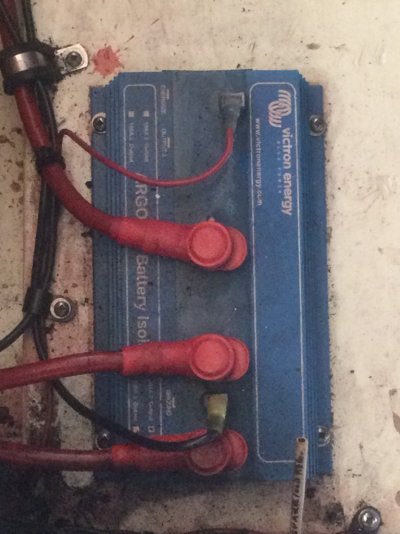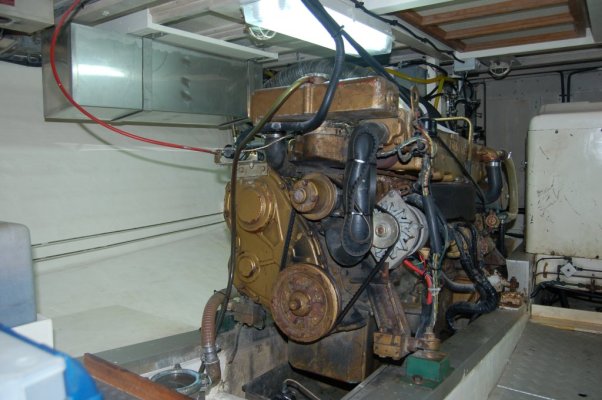Tazling
Veteran Member
- Joined
- May 17, 2021
- Messages
- 74
- Vessel Name
- DARXIDE
- Vessel Make
- Grand Banks 32
1). Alt belt replacement... On my F-L 120 (as other owners may know) to install a new alt belt you have to drain the coolant system (wth were they smoking...) and pull the main coolant hose. This is not a nice feature and I've been considering buying some feet of Fenner power-twist link belt for a quicker repair underway. Has anyone else had any experience using link belt as an alternative to stock rubber fan/alt belts? they are more expensive, but when I consider the messy and inconvenient stock belt replacement they start to look pretty good. There are endorsements and testimonials online from tractor owners, and basically my FL is a tractor engine, so...
2) My alternator just died after a year of service. It looks like this type

 www.tractorpartsasap.com
www.tractorpartsasap.com
with no brand name on it, only a part number 7127-6N
it bothers me that I bought this boat with a dead alternator, replaced it and the battery isolator, and now I have another dead alt.
But there may be a smoking gun here. I am pretty good with load-side 12v (everything from the breaker panel to the various instruments, lights, etc) but frankly, generators and alternators are voodoo to me. I had a marine electrician install the alt and a simple battery isolator from Victron Energy, about 13 months ago. Seems to me it should not have failed so soon.
The smoking gun however, is that both the previous owner and I were sailboat owners dealing with our first motor vessel, and both of us have the ingrained simple sailboat habit of switching batteries to "both" to start the engine, and leaving them ganged while the engine is running to recharge the house battery (i.e. no isolator, just 2 identical batteries and some switches).
I didn't pay much attention when the electrician installed the new parts (there were other issues including a head gasket that I was struggling with at the time). But it has occurred to me now that the battery isolator obviously "isolates" the two battery banks, house and engine; and that maybe that means it's not a good idea to gang them together, defeating the isolator. Could doing this, over time, kill an alternator? Inquiring minds would dearly like to know -- because if this is operator error then the repair path is clear: replace the alt, if necessary also the isolator, and just don't do that again. But if running in Both mode does not account for blowing up an alternator then there may be some hideous, deeper, more complicated wiring problem that I have to figure out. So I'm kinda hoping I just did something ignorant/stupid.
3). The alternator in question has only one electrical connection, the hot lead. As you can see on the web page describing it, it says only one connection is needed (it must be getting its ground via the mounting hardware and engine block). But that seems a bit sketchy to me, especially in a rusty marine environment. Would I be better off with a different brand/model of alternator with two honest connections, plus and minus?
Everything on this boat is soooo much more complicated (and bigger) than my old sailboat, I'm still a bit out of my depth here. Have completed a lot of projects and thought I was winning, but when the alternator died on my way to haulout it was rather disheartening.
2) My alternator just died after a year of service. It looks like this type

Remanufactured Alternator - Delco Style (7127-6)
Alternator - Delco Style (7127-6).
with no brand name on it, only a part number 7127-6N
it bothers me that I bought this boat with a dead alternator, replaced it and the battery isolator, and now I have another dead alt.
But there may be a smoking gun here. I am pretty good with load-side 12v (everything from the breaker panel to the various instruments, lights, etc) but frankly, generators and alternators are voodoo to me. I had a marine electrician install the alt and a simple battery isolator from Victron Energy, about 13 months ago. Seems to me it should not have failed so soon.
The smoking gun however, is that both the previous owner and I were sailboat owners dealing with our first motor vessel, and both of us have the ingrained simple sailboat habit of switching batteries to "both" to start the engine, and leaving them ganged while the engine is running to recharge the house battery (i.e. no isolator, just 2 identical batteries and some switches).
I didn't pay much attention when the electrician installed the new parts (there were other issues including a head gasket that I was struggling with at the time). But it has occurred to me now that the battery isolator obviously "isolates" the two battery banks, house and engine; and that maybe that means it's not a good idea to gang them together, defeating the isolator. Could doing this, over time, kill an alternator? Inquiring minds would dearly like to know -- because if this is operator error then the repair path is clear: replace the alt, if necessary also the isolator, and just don't do that again. But if running in Both mode does not account for blowing up an alternator then there may be some hideous, deeper, more complicated wiring problem that I have to figure out. So I'm kinda hoping I just did something ignorant/stupid.
3). The alternator in question has only one electrical connection, the hot lead. As you can see on the web page describing it, it says only one connection is needed (it must be getting its ground via the mounting hardware and engine block). But that seems a bit sketchy to me, especially in a rusty marine environment. Would I be better off with a different brand/model of alternator with two honest connections, plus and minus?
Everything on this boat is soooo much more complicated (and bigger) than my old sailboat, I'm still a bit out of my depth here. Have completed a lot of projects and thought I was winning, but when the alternator died on my way to haulout it was rather disheartening.


